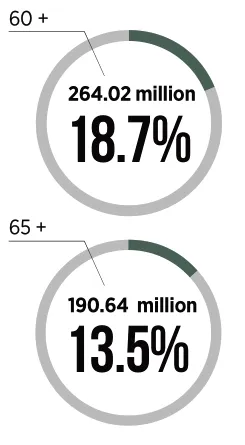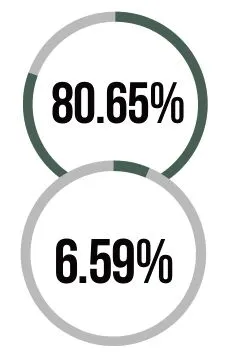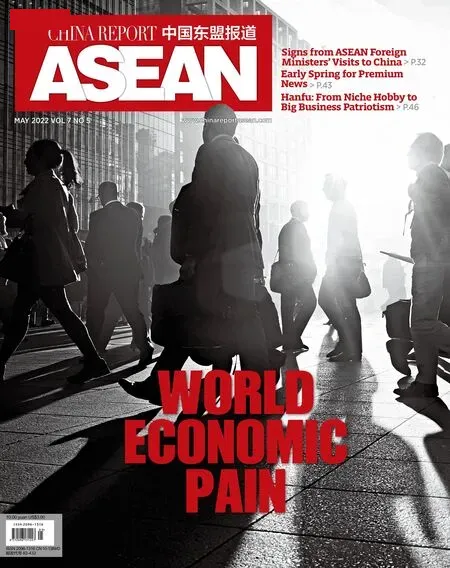Building a Family-Friendly Society
2022-06-22ByJiJing
By Ji Jing
Although China has relaxed its population policies in recent years,this has a very limited effect on the number of newborns

A nurse checks on a newborn at the People’s Hospital of Nanhe District in Xingtai,Hebei Province,on May 11,2021.(ZHANG CHI)
Xiong Yue has made up her mind not to have a second child.“It’s too energyconsuming and my family has reached a consensus not to have another kid,”the 33-year-old stay-at-home mother of a 2-year-old in Shenzhen,Guangdong Province,said.
Young people’s willingness to have children is declining in China.According to a press conference held by the National Health Commission in January,the number of children that the surveyed women of childbearing age planned to have on average was 1.76,1.73,and 1.64 in 2017,2019 and 2021,respectively.
According to the National Bureau of Statistics (NBS),the number of newborns fell to 10.62 million in 2021,marking a decline for five consecutive years,and the birthrate was 7.52 per 1,000.Both the number of newborns and birth rate were the lowest since 1949.
Total fertility rate (TFR)—the number of children per woman—fell to 1.47 in 2019 and 1.3 in 2020,below the warning line of 1.5.Demographers believe that once the TFR falls below 1.5,a country will fall into the low fertility trap and birth rates won’t easily rebound.
In the year after the universal twochild policy was introduced in 2015,the number of newborns was 17.89 million,1.31 million more than the previous year.However,the number of newborns went down to 17.23 million in 2017,15.23 million in 2018 and 14.65 million in 2019.
The China Population and Development Research Center predicted that China will enter a stage of negative population growth in 10 years.
The declining birth rate has been coupled with an exacerbating aging population problem.According to the seventh population census conducted in 2020,the number of people aged above 60 reached 264.02 million,accounting for 18.7 percent of the population,and that of those above 65 was 190.64 million,accounting for 13.5 percent of the population.
Compared with the previous census conducted a decade earlier,the seventh population census showed the proportion of the population aged above 60 increased by 5.44 percentage points and that of people above 65 rose by 4.63 percentage points.
According to international standards,a country or region is defined as an aging society when its 65-plus population reaches 7 percent of the population,and a deeply aging society when its 65-plus population reaches 14 percent of the population.According to such standards,China became an aging society in 2000 and was on the edge of a deeply aging society in 2020,with its 65-plus population reaching 13.5 percent.
Diminished Desire
There are multiple complicated reasons behind the declining birth rate.
First of all,the number of women of childbearing age (15-49) dropped by 5 million in 2021 compared with the previous year,of which women aged 21 to 35 decreased by around 3 million,according to the NBS.
The mindset regarding childbirth has also changed.Traditional conceptions of having children to continue the family line or bringing up children to support parents in their old age have been weakened,even in rural areas.As those born after 1990,and even 2000,become the primary force of childbearing,they are delaying marriage and childbirth as their time of education increases and they face more competition on the job market.
In addition,as the costs of bringing up a child mount,many are reluctant to have more than one.According to an online survey of 1,205 people in 64 cities across China,conducted by China Economic Times in May last year,80.65 percent of those surveyed considered the economic costs of raising and educating children too high and 6.59 percent said they lacked the time to take care of kids.
Chu Haonan,deputy director of the Human Resources Research Institute at the China University of Labor Relations,said the primary reason for the reluctance to have children is the high cost of childbirth and care,which includes childrearing,education and time costs.
“If a family is financially incapable of raising a child or their quality of life will be significantly affected by having a child,they will choose not to have one.Or if they are uncertain about government policies and social welfare,they will be unwilling to have children,”Chu said.
He Dan,director of the China Population and Development Research Center,said it is natural that social and economic development brings down birth rates.
The COVID-19 pandemic has also contributed to the reduced birth rate as people have postponed marriage and childbirth out of concerns over job and income instability,she said.
China introduced the family planning policy in the late 1970s,allowing all couples to have only one child,with exceptions for ethnic minority groups and people in rural areas whose first child was a girl.In recent years,the policy has been relaxed multiple times,and all couples were allowed to have two children from 2015 onward.On July 20 last year,the Communist Party of China (CPC) Central Committee and the State Council passed a decision on improving birth policies to promote longterm and balanced population development,whereby all couples are allowed to have three children.
Peng Xizhe,director of the Center for Population and Development Policy Studies at Fudan University,said although China has relaxed its population policies in recent years,this has a very limited effect on the number of newborns.That number experienced a temporary rebound after the two-child policy was introduced,but began to decrease soon after.

The number of children that the surveyed women of childbearing age planned to have on average was1.76,1.73,and1.64in 2017,2019 and 2021,respectively.

According to the seventh population census conducted in 2020,the number of people aged above 60 reached264.02 million,accounting for18.7 percentof the population,and that of those above 65 was190.64 million,accounting for13.5 percentof the population.

According to an online survey of 1,205 people in 64 cities across China,conducted by China Economic Times in May last year,80.65 percentof those surveyed considered the economic costs of raising and educating children too high and6.59 percentsaid they lacked the time to take care of kids.
Demographer Mao Daqing said there was a population peak from 1985 to 1994,when a total of 184 million people were born.These people are now aged 28 to 37 and constitute the major childbearing force.“However,the number of these people who have given birth to one child is limited and the number of those who have given birth to two children is smaller still,not to mention a third child,”Mao said.
A Family-friendly Society
The birth policy adjustment needs to be supported by relevant measures.Only by reducing families’ child-rearing burdens can the birth policy adjustment achieve its desired effect.
Experts say birth and childrearing support is not an isolated policy that can be implemented by a single department,but needs to be a comprehensive system that requires the concerted efforts of multiple government departments as well as social services.Employment,taxation and housing policies should all be revised to reduce the financial burden of families with one or multiple children and promote the formation of a family-friendly society.
Low fertility rate is not a social problem unique to China.Long before China,Europe already encountered fertility rates lower than the replacement level.Some European countries have implemented policies to extend maternity leave,provide free childcare and provide subsidies to ensure women’s employment.Compared with these countries,China still has a long way to go to become a family-friendly society.

A newlywed couple in Baokang County,Hubei Province,pose for a photo after receiving their marriage certifciate on February 22,2022.(VCG)
Peng suggested lifting restrictions on births.“Although such a move may have little effect on increasing the birth rate,it will serve as a guidance for the whole society and accelerate the unleashing of birth potential,”he said.
Following the issuance of the decision on improving birth policies by the CPC Central Committee and the State Council,provinces and municipalities across the country have revised their population and family planning regulations to improve birth rates and create a family-friendly environment.For instance,Beijing has increased women’s extended maternity leave from 30 to 60 days and allows parents who have children under 3 to enjoy five days of childcare leave every year.In Hebei,Jiangxi and Zhejiang provinces,women who give birth to a second or third child are allowed to extend their maternity leave by 90 days.
Yang Ge,a researcher with the Institute of Population and Labor Economics at the Chinese Academy of Social Sciences,said extended maternity leave enables mothers to have more time to look after their children but an overly long leave might increase women’s disadvantage in the job market as employers might avoid employing women due to the additional cost.Therefore,there should be relevant measures to prevent longer maternity leave from harming women’s employment rights.
Dong Yuzheng,director of the Guangdong Academy of Population Development,said a system for dividing the cost of maternity leave between different parties should be established.If the cost is shouldered by employers only,it will add to the employers’ burden and exacerbate gender discrimination in recruitment,which will eventually affect women’s willingness to have children.
Improving care services for children under 3 is also considered important for reducing parental burdens.Care services for children under 3 are lacking in China,with most of these children taken care of by their families.
According to the 14th Five-Year Plan(2021-25),a blueprint for the country’s economic and social development during the period,the number of nursery slots per 1,000 children under 3 will rise to 4.5 in 2025 from 1.8 in 2020.National and local departments have rolled out policies to encourage the development of inclusive nursery services.
Such policies might be effective.However,Yang said preschool services should be tailored to cater to different families’ differentiated demands.“The preschool industry should pursue high quality development and implement stricter supervision and approval systems than other industries so as to enable children to receive healthy and scientific early education.Also,the sustainability of nurseries requires more attention.Massive financial subsidies will prompt the rapid expansion of the preschool industry but whether the industry can be sustainable should be further assessed.”
Cash subsidies,tax reductions and favorable housing policies for people with children are some ways to reduce parents’ financial pressures.
Huang Xihua,a deputy to the 13th National People’s Congress,the nation’s top legislature,and head of the Publicity Department of CPC Huizhou City Committee in Guangdong Province,said she suggested providing monthly subsidies for parents of children from birth up to 6 with the amount set according to local minimum wages.
Zhong Maochu,a professor at the Institute of Economics of Nankai University,suggested using an individual income tax adjustment policy to reduce parents’ financial burdens and increase birth rates.He suggested the individual taxable income of parents of children under 18 be reduced by 1,000 yuan (US$157) per month for every child they have.For those who don’t earn enough to be taxed,he suggested offering 1,000 yuan in subsidies per month for every child they have.Zhong said the state finances can afford the subsidies.“In the short and medium term,the potential consumption generated by the subsidies can make up for the fiscal spending;in the long term,the demographic dividend will far outweigh the spending,”he said.
Starting from January 1,the individual taxable income of parents with children under 3 can be reduced by a total of 1,000 yuan per month for each baby,said a State Council circular,issued on March 28.The deduction can be applied in full to one parent’s income or be split evenly.
Liu Jie,a research fellow with the industrial economy research center at China Development Institute,said preferential policies for housing rental and purchase should be offered according to the number of children a family has.Liu suggested lowering down payment requirements and said that the number of children a family has could also be taken into account when applying for public rental housing.
To increase birth rates,those who have difficulties conceiving should also be given special attention.NBS statistics show that the infertility rate of childbearing age couples has reached 12 to 18 percent.Peng said assisted reproduction technologies should be promoted to tap into the potential of this group.
